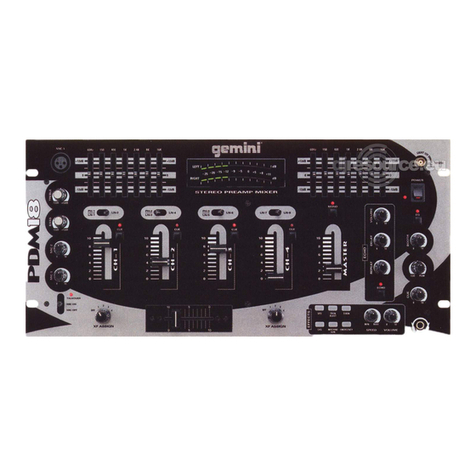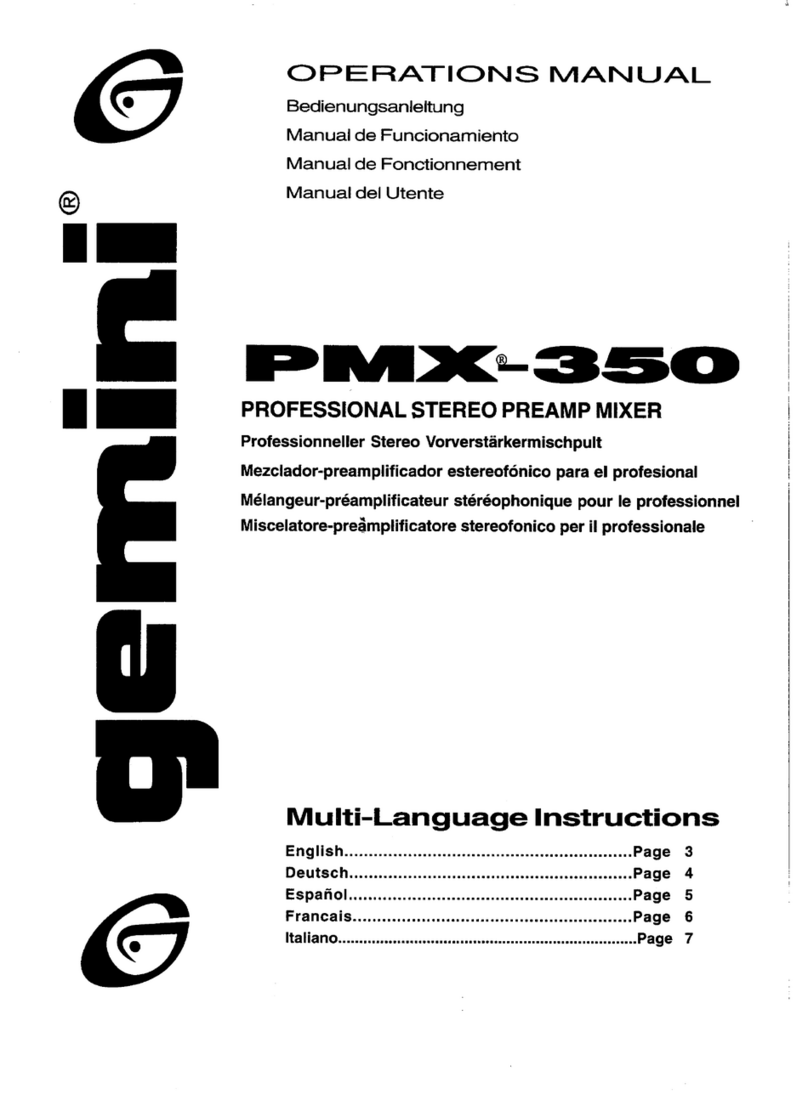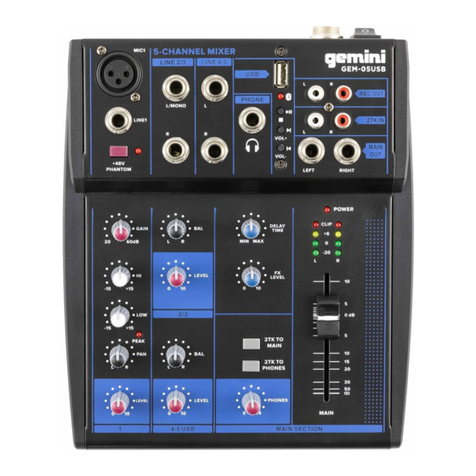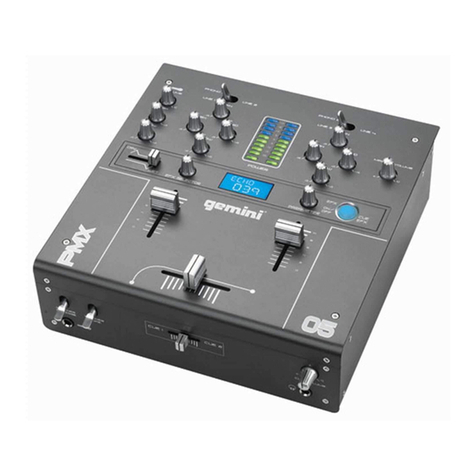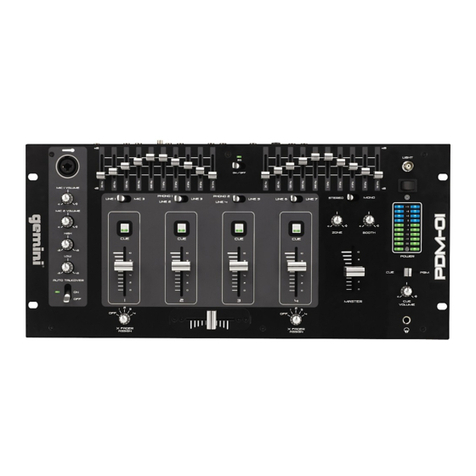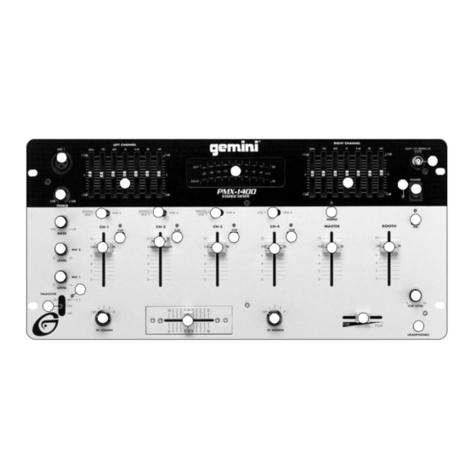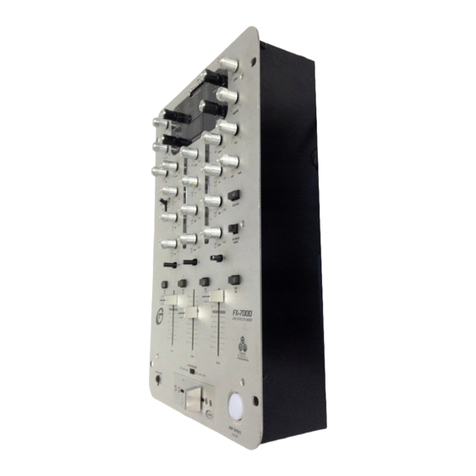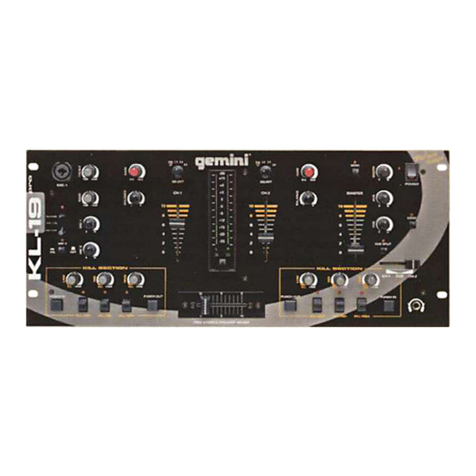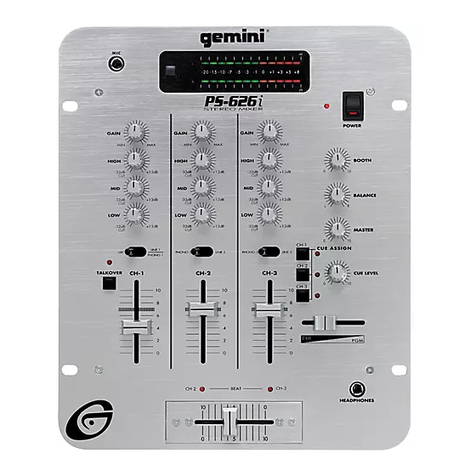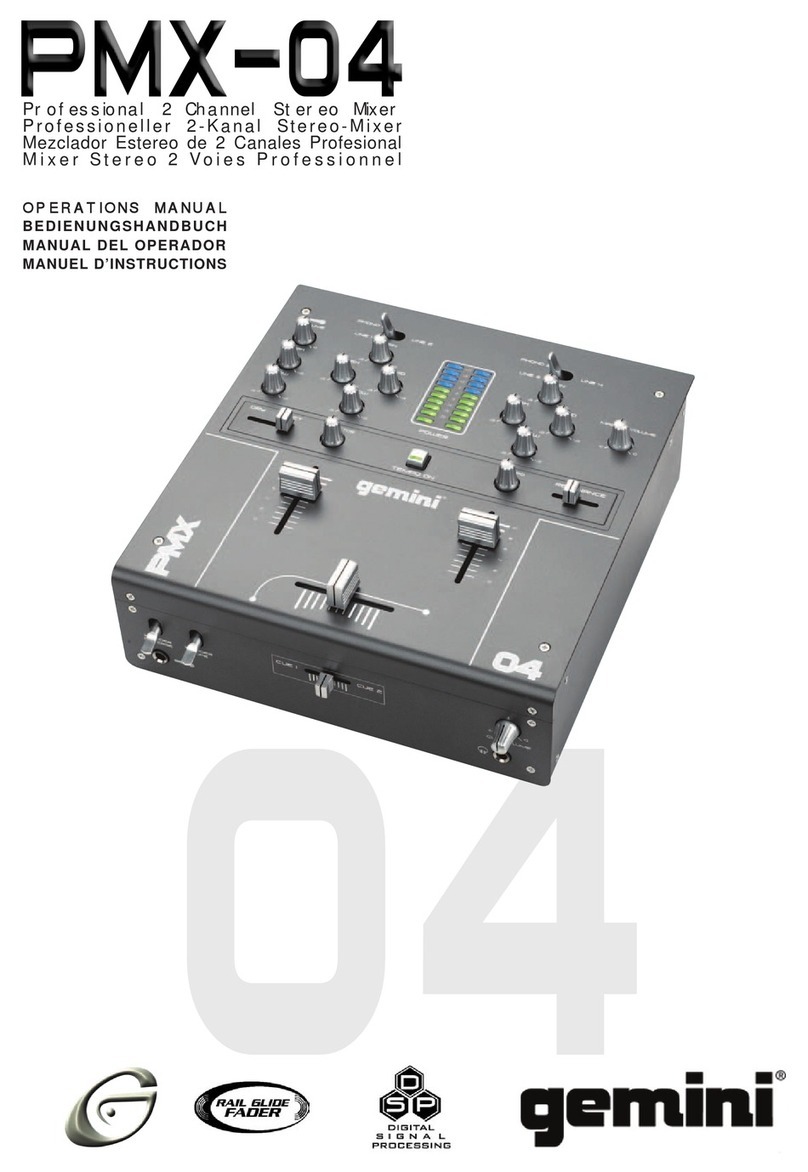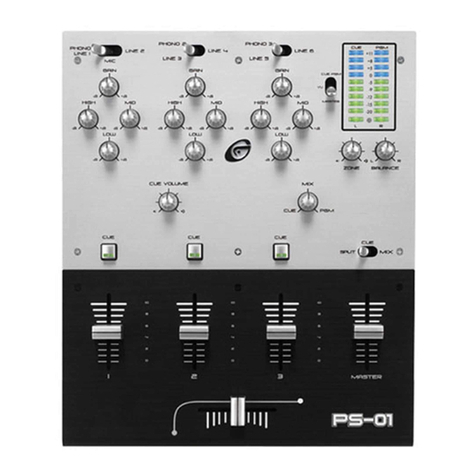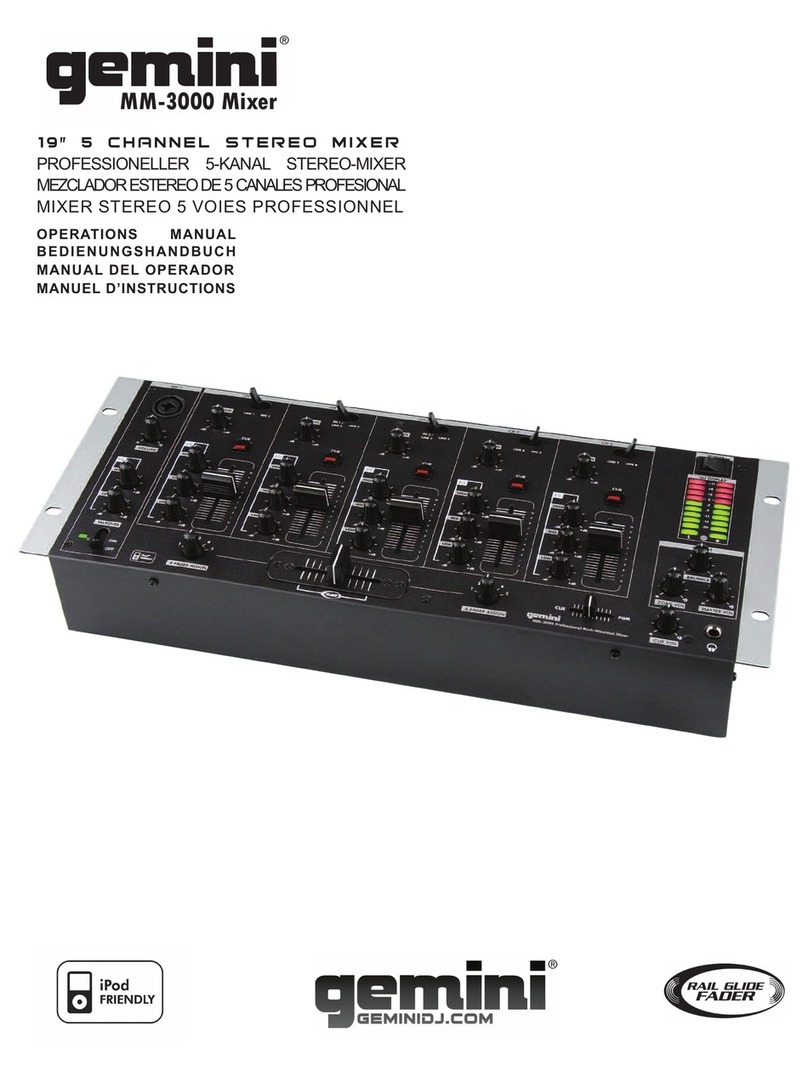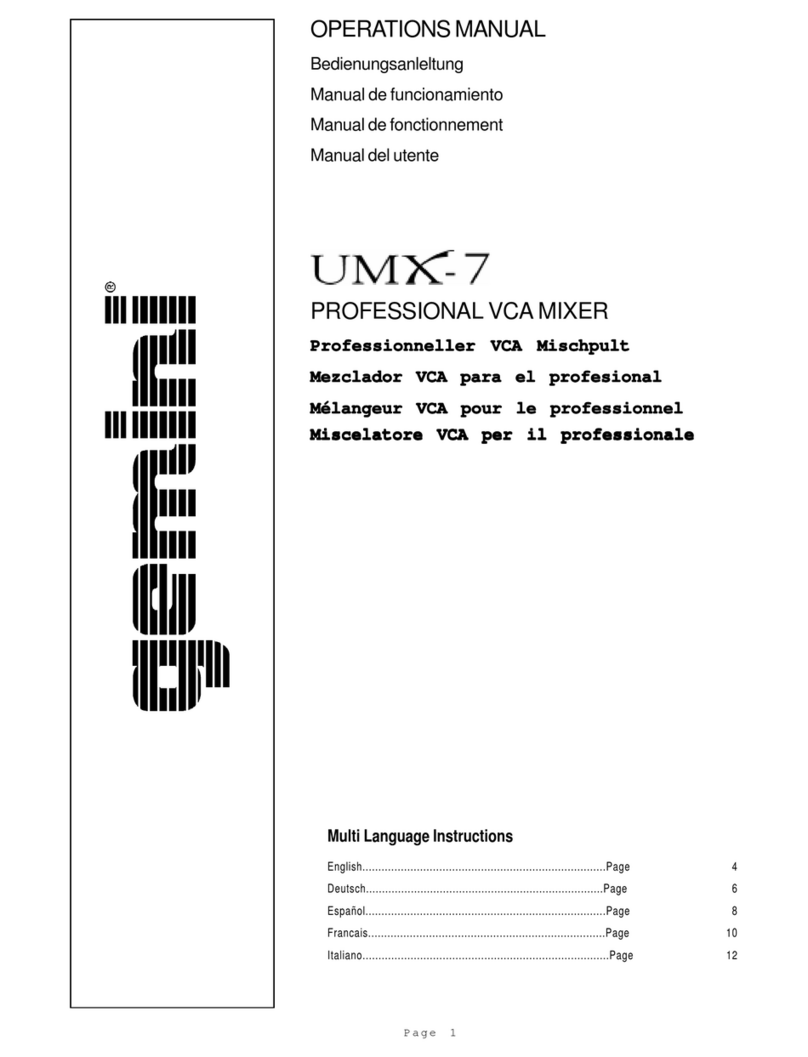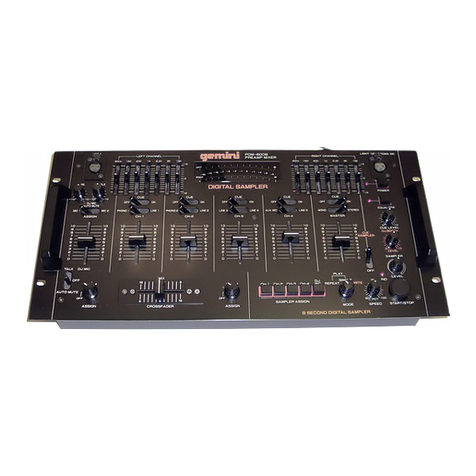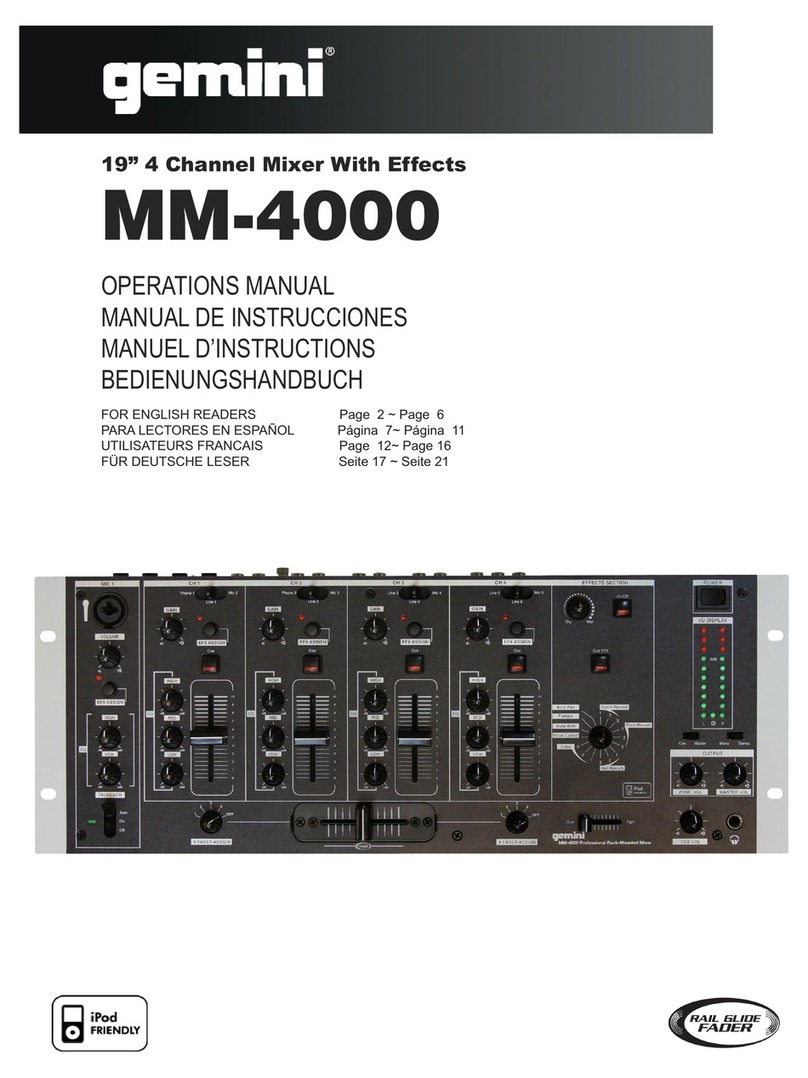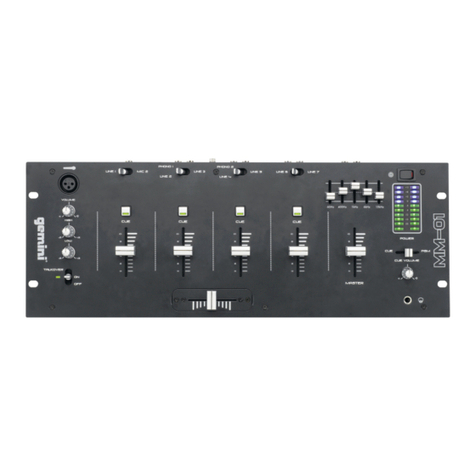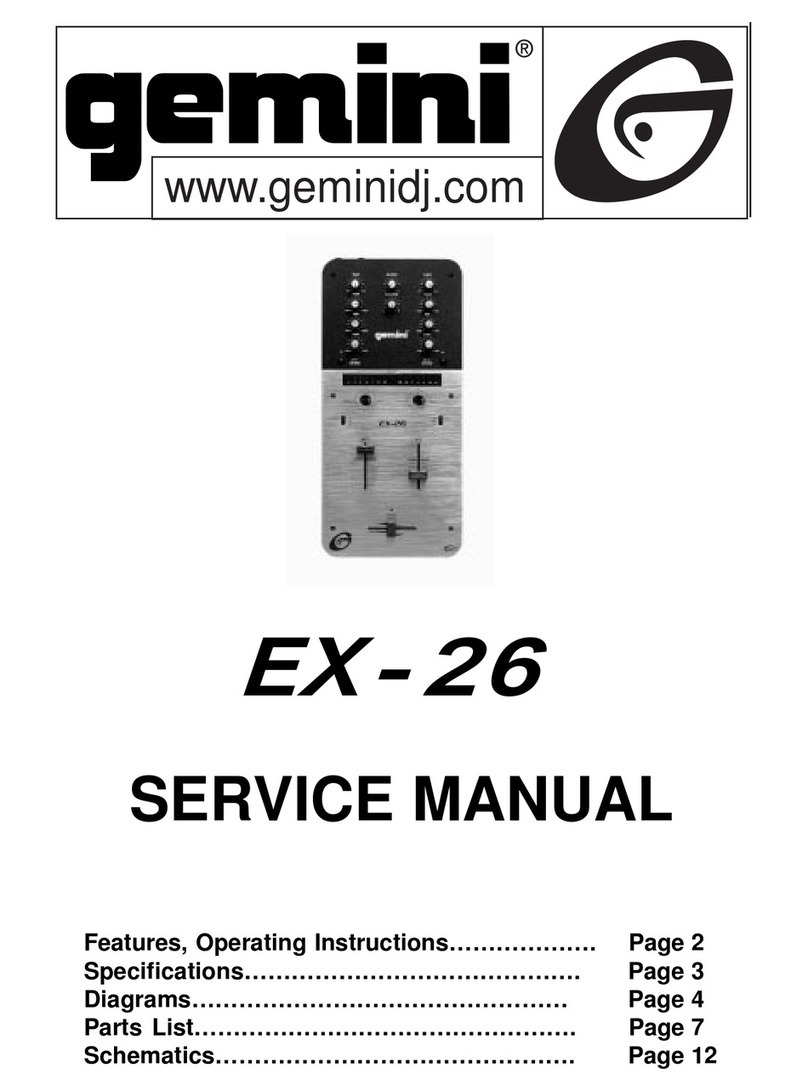
Page 4
Einleitung
Wir gratulieren Ihnen zum Kauf eines Gemini PMX-140 Mischpults. Dieses
moderne Mischpult enthält die neuesten Funktionen mit dreijähriger
Garantie, ausscheließlich crossfader und Kanalschieber. Vor
Anwendung dieses Mischpults bitte alle Anweisungen sorgfältig
durchlesen.
Funktionen
• 2 Stereokanäle
• 2 konvertierbare Eingänge für Phonoleitungen/Leitung, Eingänge für 1
Phonoleitungen, Eingänge für 1 Leitungen, Eingang für 1 Mikrophon
• Buchse für DJ Mikrophon (1/4")
• Steuerungen für Tiefton, Mitte, Hochton und Verstärkungsfaktor für
jeden Kanal
• Ausgänge für Master mit regler
• Cue
Vorsichtsmaßnahmen
1. Vor Anwendung dieses Geräts bitte alle Anweisungen sorgfältig
durchlesen.
2. Das Gerät nicht öffnen, um das Risiko elektrischen Schocks zu
vermeiden.EsenthältKEINE VOMANWENDERERSETZBARENTEILE.
Die Wartung darf nur von befähigten Wartungstechnikern
durchgeführt werden.
3. Das Gerät von direktem Sonnenlicht oder einer Wärmequelle wie
Heizkörper oder Ofen aussetzen.
4. Dieses Gerät darf nur mit einem feuchten Tuch gesäubert werden.
Keine Lösungs- oder Reinigungsmittel benutzen.
5. Bei Umzügen sollte das Gerät in seinem ursprünglichen Versandkarton
und Verpackungsmaterial verpackt werden. Dadurch verhindert man,
daß das Gerät während des Transportes beschädigt wird.
6. DIESESGERÄTNICHTREGENODERFEUCHTIGKEITAUSSETZEN.
7. ANDENREGLERNODERSCHALTERNKEINSPRAY-
REINIGUNGSMITTELODERSCHMIERMITTELBENUTZEN.
Anschlüsse
1. Bevor das Netzkabel eingesteckt wird, ist sicherzustellen, daß der
Schalter VOLTAGE SELECTOR (2) (Spannungswahl) auf die richtige
Spannung gestellt ist.
HINWEISHINWEIS
HINWEISHINWEIS
HINWEIS: Dieses Produkt ist doppelt isoliert und darf
nicht geerdet werden.
2. Sicherstellen, daß sich der Netzschalter POWER (1) in der Aus-Stellung
befindet.
3. Beim Mischpult PMX-140 sind 2 Sätze von Ausgangsanschlüssen
vorgesehen. Die Anschlüsse OUTPUT AMP (3) (Verkstärkerausgang)
dienen zum Anschließen des Hauptverstärkers. Die Anschlüsse
OUTPUT REC (5) (Aufzeichungsausgang) können dazu verwendet
werden, das Mischpult an den Aufzeichnungseingang des Rekorders
anzuschließen, um die Mischung aufzuzeichnen.
4. Der Eingang DJ MIC (28) (an der Vorderseite) nimmt Anschlüsse mit
Durchmesser von 0,38 mm (1/4"), und balancierte und unbalancierte
Mikrophone auf.
5. An der Rückwand sind jeweils 2 Stereoeingänge PHONO/LINE (7, 11),
1 Stereoeingänge für PHONO (12) und 1 LEITUNG - LINE (6)
angebracht. Die Schalter PHONO/LINE SWITCHES (8, 10) ermöglichen
Ihnen, die Eingänge (7, 11) an Phono oder Line anzuschließen. Die
Phono-Eingänge werden nur Plattenspieler mit einem magnetischem
Tonabnehmer aufnehmen. Eine Erdungschraube GROUND SCREW (9)
zur Erdung des Plattenspielers ist an der Rückwand angebracht. Die
Stereo-Leitungseingängen nehmen Geräte wie CD- oder
Kassettenspieler auf.
6. Kopfhörer können an der an der Vorderwand montierten Kopfhörer-
Buchse HEADPHONE (47) eingesteckt werden.
Benutzung des Masse-Trennschalters
Abhängig von Ihrer Systemkonfiguration, wenn man hin und wieder
Masse anlegt, kann man damit einen ruhigeren Signalpfad schaffen.
Wenn man hin und wieder die Masse trennt, kann man dadurch
Massekreise und Brummen eliminieren, um einen ruhigeren Signalpfad
schaffen.
1. Wenn das Mischpult eingeschaltet ist, das System im Ruhemodus
(ohne Signal) bei angelegter Masse abhorchen (der Masse-
Trennschalter - GROUND LIFT SWITCH (4) ist nach links
geschaltet).
2. Dann den Leistungsschalter ausschalten bevor der Masse-
Trennschalter - GROUND LIFT SWITCH (4) betätigt wird. Den
Masse-Trennschalter nach rechts legen, die Leistung wieder
einschalten und horchen, um zu bestimmen, welche Position ein Signal
ohne Grundgeräusch und Brummen erzeugt. Den Masse-
Trennschalter in Masseposition halten, falls der Geräuschpegel in
beiden Position unverändert bleibt.
VORSICHT:DIEMASSEINKEINERWEISEAMMISCHPULTABSCHLIESSEN.
DERENDABSCHLUSSDERMASSEKANNMITGEFAHRENVERBUNDEN
SEIN.
Bedienung
1. STROM EIN: Nachdem Sie das Gerät am Mischpult angeschlossen
haben, drücken Sie auf die Taste POWER (1).
2. KANAL 1: Die Regelelemente GAIN (13), HIGH (20), MID (21),und
LOW (22) ermöglichen ein vollkommenes Regulieren der
ausgewählten Tonquelle. Schalter # (23) ermöglicht, den Eingang von
PHONO 1 (12) oder PHONO 2/LINE 1 (11) auszuwählen. CHANNEL
SLIDE (24) regelt den Ausgangstonsignal dieses Kanals.
3. KANAL 2: Die Regelelemente GAIN (41), HIGH (33), MID (34) und
LOW (35) ermöglichen ein vollkommenes Regulieren der
ausgewählten Tonquelle. Schalter # (36) ermöglicht, den Eingang von
PHONO 3/LINE 2 (7) oder LINE 3 (6) auszuwählen. CHANNEL SLIDE
(37) regelt den Ausgangstonsignal dieses Kanals.
HINWEISHINWEIS
HINWEISHINWEIS
HINWEIS: Für jeden Kanal gibt es niedrige (Low), mittlere
(Mid) und hohe (High) Entzerrung mit einem äußerst breiten
Regulierbereich, welches eine gleichförmigere Mischung
bietet.
4. BESEITIGUNG VONFREQUENZEN:Es gibt zweiMöglichkeiten,
Frequenzen zu beseitigen, indem man die Schalter LOW (25, 38), MID
(26, 39) und HIGH (27, 40) drückt. Jeder KILL SWITCH hat drei
Positionen: Latch, Normal und Flash. Wenn der ausgewählte KILL
SWITCH ganz nach oben in die Latch-Position (ON) geschoben wird,
bleibt der Schalter in dieser Position, und die Frequenz wird beseitigt.
Wird der ausgewählte KILL SWITCH in die mittlere Position geschoben,
ist die Beseitigungsfunktion nicht aktiv, und die Frequenz wird nicht
beseitigt. Wird der ausgewählte KILL SWITCH in die untere Flash-
Position geschoben und dort gehalten, wird die Frequenz beseitigt.
Wird der ausgewählte KILL SWITCH in der unteren Position
freigegeben, wird er in die mittlere Position zurückgeführt, und die
Frequenz wird nicht beseitigt.
RATSCHLAG: Sie können die CUT Funktion und die Kill-Features
eine jeden Kanals benutzen, um Low, Mid und/oder High zu
entfernen um dadurch Spezialeffekte zu erziehlen.
